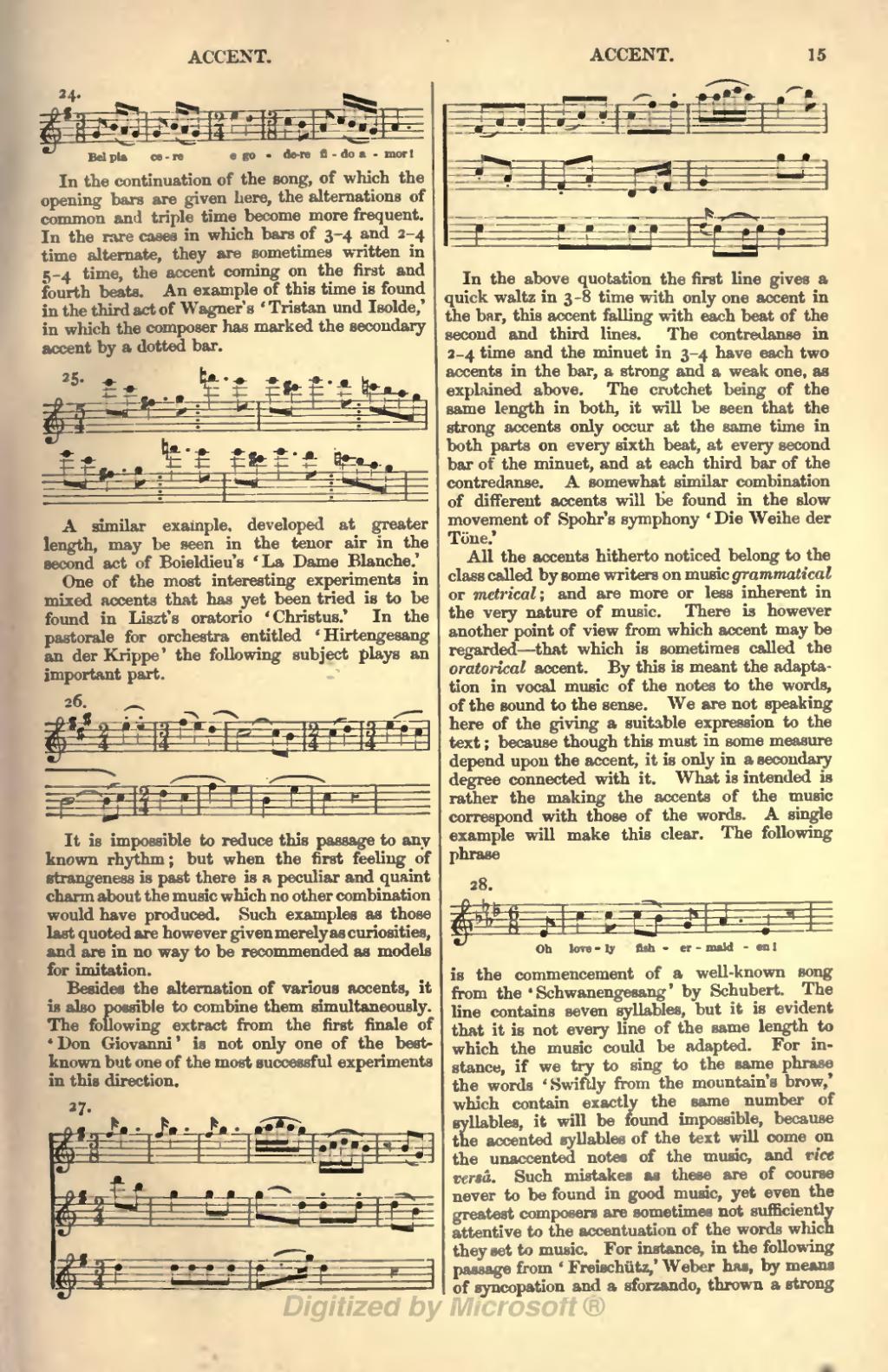![{ \time 3/8 { \key g \major \relative g' { \mark \markup \small "24." \autoBeamOff g8 b16([ a g8)] | g b16([ a g8)] | \time 2/4 e'4 d | \time 3/8 c b8 | a c16([ b a g)] | a4. } }
\addlyrics { Bel pia ce -- re e go -- de -- re fi -- "do a" -- mor! } }](http://upload.wikimedia.org/score/l/6/l6z0sa47qljwv5tzekvuy7kgrwk7x3m/l6z0sa47.png)
In the continuation of the song, of which the opening bars are given here, the alternations of common and triple time become more frequent. In the rare cases in which bars of 3-4 and 2-4 time alternate, they are sometimes written in 5-4 time, the accent coming on the first and fourth beats. An example of this time is found in the third act of Wagner's 'Tristan und Isolde,' in which the composer has marked the secondary accent by a dotted bar.

A similar example, developed at greater length, may be seen in the tenor air in the second act of Boieldieu's 'La Dame Blanche.'
One of the most interesting experiments in mixed accents that has yet been tried is to be found in Liszt's oratorio 'Christus.' In the pastorale for orchestra entitled 'Hirtengesang an der Krippe' the following subject plays an important part.

It is impossible to reduce this passage to any known rhythm; but when the first feeling of strangeness is past there is a peculiar and quaint charm about the music which no other combination would have produced. Such examples as those last quoted are however given merely as curiosities, and are in no way to be recommended as models for imitation.
Besides the alternation of various accents, it is also possible to combine them simultaneously. The following extract from the first finale of 'Don Giovanni' is not only one of the best-known but one of the most successful experiments in this direction.
![\version "2.14.2"
\header {
tagline = ##f }
\layout {
\context {
\Score
\remove "Timing_translator"
\remove "Default_bar_line_engraver"
}
\context {
\Staff
\consists "Timing_translator"
\consists "Default_bar_line_engraver"
}
}
% Now each staff has its own time signature.
\score { \relative g'' <<
\new Staff {
\time 2/8
\set Staff.timeSignatureFraction = #'(3 . 8)
\key g \major
\mark \markup \small "27."
\repeat unfold 3 { \grace fis16 g4.*2/3 } g16*2/3[( a b a g8*2/3])
b,16*2/3[( c d c b8*2/3]) r8*2/3 b( g) fis( a) a-. a( c) c-.
c( fis) fis-. a[( a16*2/3 b c a]) g4*2/3( b8*2/3)
}
\new Staff {
\time 2/4 \key g \major \partial 4
\grace s16 d8 b | g4 g8 g | g( d) d-. d-. |
d( b) c-. a-. | fis-. a-. d, e16 fis | g4 g'8 g
}
\new Staff {
\time 3/4 \key g \major \override Staff.Rest #'style = #'classical
\grace s16 d4 d8 d d d | d8.( g16) d4 r |
c4 c8 c c c | \grace d16 c8( b16 c) b4
}
>>
\midi { }
\layout { } }](http://upload.wikimedia.org/score/d/h/dhfpe0i3z5qltb0dxrstmn5bhoodx87/dhfpe0i3.png)
In the above quotation the first line gives a quick waltz in 3-8 time with only one accent in the bar, this accent falling with each beat of the second and third lines. The contredanse in 2-4 time and the minuet in 3-4 have each two accents in the bar, a strong and a weak one, as explained above. The crotchet being of the same length in both, it will be seen that the strong accents only occur at the same time in both parts on every sixth beat, at every second bar of the minuet, and at each third bar of the contredanse. A somewhat similar combination of different accents will be found in the slow movement of Spohr's symphony 'Die Weihe der Töne.'
All the accents hitherto noticed belong to the class called by some writers on music grammatical or metrical; and are more or less inherent in the very nature of music. There is however another point of view from which accent may be regarded—that which is sometimes called the oratorical accent. By this is meant the adaptation in vocal music of the notes to the words, of the sound to the sense. We are not speaking here of the giving a suitable expression to the text; because though this must in some measure depend upon the accent, it is only in a secondary degree connected with it. What is intended is rather the making the accents of the music correspond with those of the words. A single example will make this clear. The following phrase
![{ \time 6/8 \key aes \major \partial 8 \mark \markup \small "28." \relative e' { ees8 | c'4 c8 c([ bes)] g | aes4. ees4 r8 | s8 }
\addlyrics { Oh love -- ly fish -- er -- maid -- en! } }](http://upload.wikimedia.org/score/i/0/i0dxeqf3nmwgabysknjdhq2lczar875/i0dxeqf3.png)
is the commencement of a well-known song from the 'Schwanengesang' by Schubert. The line contains seven syllables, but it is evident that it is not every line of the same length to which the music could be adapted. For instance, if we try to sing to the same phrase the words 'Swiftly from the mountain's brow,' which contain exactly the same number of syllables, it will be found impossible, because the accented syllables of the text will come on the unaccented notes of the music, and vice versa. Such mistakes as these are of course never to be found in good music, yet even the greatest composers are sometimes not sufficiently attentive to the accentuation of the words which they set to music. For instance, in the following passage from 'Freischütz,' Weber has, by means of syncopation and a sforzando, thrown a strong

